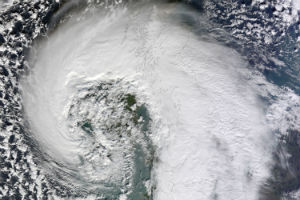More sting jet storms likely due to global warming
19 March 2018

The UK could be hit by more than double the number of storms with exceptional windspeeds, like the one that caused mayhem across south east England in October 1987, if global warming continues, scientists have warned.
University of Reading scientists have shown for the first time that nearly half of all cyclones in the North Atlantic region may be accompanied by powerful sting jets in a warmer climate – an increase of 40% on the present-day. They also show there will be an increase of 60% in dangerous weather bombs with sting jets.
More of these storms will track over Europe, more than doubling the UK’s risk of strong winds that can exceed 100mph, says the study published in the journal Environmental Research Letters.
Dr Oscar Martínez-Alvarado, meteorologist at the University of Reading and the National Centre for Atmospheric Science, and lead author of the paper, said: “This research backs up the theory that the warmer, moister climate predicted in the future due to climate change is an ideal breeding ground for the kind of powerful storms that cause the most severe damage.
“The findings show what impact carbon emissions are having on the world, and how they could change it in the years to come. Increased numbers of storms would wreak havoc on people’s lives and leave Britain facing a spiralling clean-up bill.”
Sting jets are descending jets of air that accelerate as they descend, causing strong surface winds and gusts focused within a relatively small area of the storm. They get their name from the shape of the tail of the cloud that swirls around the area of low pressure at the centre of the storm, and are the most damaging type of winter storm to affect north-west Europe.
The infamous Great Storm that hit the UK in October 1987 was the first published case in which a sting jet was identified. It produced winds of 115mph and knocked over an estimated 15 million trees.
Weather bombs occur when air pressure at the centre of a cyclone drops by more than about 24 millibars within 24 hours. The 1987 storm was a weather bomb that developed off the west coast of France.
In the study, the scientists assessed, for the first time, sting-jet storms in simulations of winter (September-May) weather in the North Atlantic and Europe over respective 13-year periods for both the present day climate and that predicted for the end of the century. Although the number of cyclones decreases slightly, they found that, if the levels of greenhouse gases continue to rise as expected throughout the 21st century, 45% of cyclones in 2100 would have associated sting jets, compared to 32% today.
The simulations also revealed that the proportion of sting-jet cyclones that could be defined as weather bombs, and therefore carry the greatest wind risk, increased from 9% to 14%.
Other exceptional windstorms in recent years include Cyclone Friedhelm, which brought hurricane-force winds to Scotland in 2011, Cyclone Ulli, which affected the UK and other parts of Europe in 2012, and St Jude’s Day storm, which batter southern England in 2013.
The research team carried out simulations for the end of the century using the most extreme climate change scenario from the Intergovernmental Panel on Climate Change (IPCC), which assumes greenhouse gas emissions are assumed to continue to rise through the 21st century.
Full reference
Martinez-Alvarado, O; Gray, S; Hart, N; Clark, P; Hodges, K; Roberts, M (2018). Increased wind risk from sting-jet windstorms with climate change. Environmental Research Letters. Doi: 10.1088/1748-9326/aaae3a
